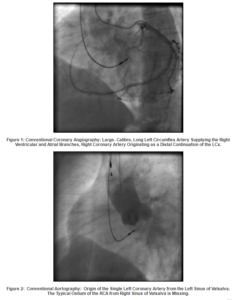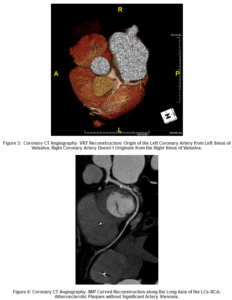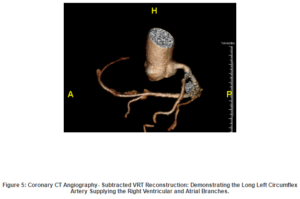However, rarely the single coronary artery with origination of the RCA from the distal LCx is, there can be found a handful of case reports in the recent scientific literature, that demonstrate the same or similar findings, that we encountered in our patient, as well as very useful comments on classification and nomenclature. 13-17
Conclusion
Coronary artery anomalies should be regarded as a diverse group of congenital disorders, whose manifestations and pathophysiological mechanisms are highly variable. Some of the anomalies like myocardial bridges are surely encountered in more than 1% of patients, and probably should be considered normal variant. Some other may have life-threatening consequences or may be encountered with other cardiac anomalies. The cardiac CT plays a key role in diagnostic algorithm of coronary artery variations imaging, and allows perfect anatomic depiction of the coronary artery course.
References
1. Yamanaka, O. & Hobbs, R. E. (1990). “Coronary Artery Anomalies in 126,595 Patients Undergoing Coronary Arteriography,” Catheterization and Cardiovascular Diagnosis, 21 28-40.
Publisher – Google Scholar
2. Alexander, R. W. & Griffith, G. C. (1956). “Anomalies of the Coronary Arteries and Their Signiï¬cance,” Circulation, 14 800-805.
Publisher – Google Scholar
3. Angelini, P., Velasco, J. A. & Flamm, S. (2002). “Coronary Anomalies: Incidence, Pathophysiology, and Clinical Relevance,” Circulation, 105 2449-2454.
Publisher – Google Scholar
4. Lipton, M. J., Barry, W. H., Obrez, I. et Al. (1979). “Isolated Single Coronary Artery: Diagnosis, Angiographic Classification, and Clinical Significance,” Radiology, 130 39-47
Publisher – Google Scholar
5. Desmet, W., Vanhaecke, J., Vrolix, M. et al. (1992). “Isolated Single Coronary Artery: A Review of 50,000 Consecutive Coronary Angiographies,” European Heart Journal, 13 1637-1640.
Publisher – Google Scholar
6. Memisoglu, E., Hobikoglu, G., Tepe, M. S. et al. (2005). “Congenital Coronary Anomalies in Adults: Comparison of Anatomic Course Visualized by Catheter Angiography and Electron Beam CT,” Catheterization and Cardiovascular Interventions, 66 34-42.
Publisher – Google Scholar
7. Fiss, D. M. (2007). “Normal Coronary Anatomy and Anatomic Variations,” Applied Radiology, vol. 36 (1) 14-26.
Publisher – Google Scholar
8. Morettin, L. B. (1976). “Coronary Arteriography: Uncommon Observations,” Radiologic Clinics of North America, 14 189-208.
Publisher – Google Scholar
9. Donaldson, R. M. & Raphael, M. J. (1982). “Missing Coronary Artery- Review of Technical Problems in Coronary Arography Resulting from Anatomical Variants,” British Heart Journal, 47 62-70.
Publisher – Google Scholar
10. Gensini, G. G. (1975). ‘Coronary Arteriography,’ Mount Kisco, NY: Futura Publishing Co, 260—274.
Google Scholar
11. O’Brien, J. P., Srichai, M. B., Hecht, E. M. et Al. (2007). “Anatomy of the Heart at Multidetector CT: What the Radiologist Needs to Know,” RadioGraphics, 27 1569-1582.
Publisher – Google Scholar
12. Rajiah, P., Halliburton, S. S., Scott, F. D. et Al. (2012). “Strategies for Dose Reduction in Cardiovascular Computed Tomography,” Applied Radiology, 41 (7-8) 10-15.
Publisher
13. Desai, A. V., Parikh, P. & La Barbera, M. (2013). “Anomalous Right Coronary Artery Originating from Left Circumflex Artery: An Unusual Single Coronary Artery Anomaly,” Cath Lab Digest 21 (2) 22.
Publisher – Google Scholar
14. Chung, S. K., Lee, S. J., Park, S. H. et Al. (2010). “An Extremely Rare Variety of Anomalous Coronary Artery: Right Coronary Artery Originating from the Distal Left Circumflex Artery,” Korean Circulation Journal 2010; 40(9):465-7.
Publisher – Google Scholar
15. Andreou, A. Y., Tryfonos, A., Christodoulou, C. et Al. (2012). “Isolated single Coronary Artery with Dual Right Coronary Artery Distribution. A Rare Anatomical Variation,” Herz. 2012; 37(4):432-5.
Publisher – Google Scholar
16. Angelini, P. (2007). “Coronary Artery Anomalies: An Entity in Search of an Identity,” Circulation. 2007 Mar 13; 115(10):1296-305.
Publisher – Google Scholar
17. Angelini, P. (2008). “An Illustrative Case of a Frequently-Held Misconception: The “Absent” RCA,” Journal of Invasive Cardiology 2008; 20(7):384.
Publisher – Google Scholar





